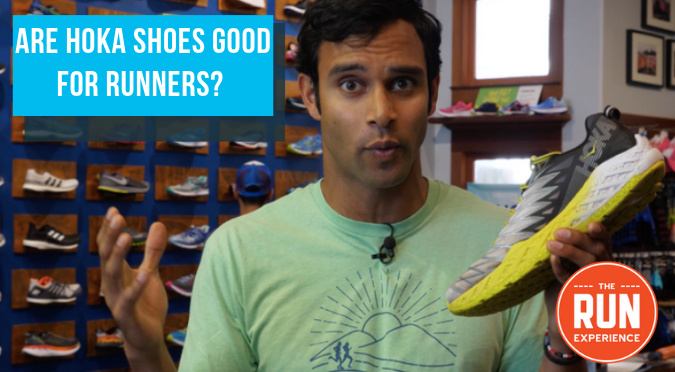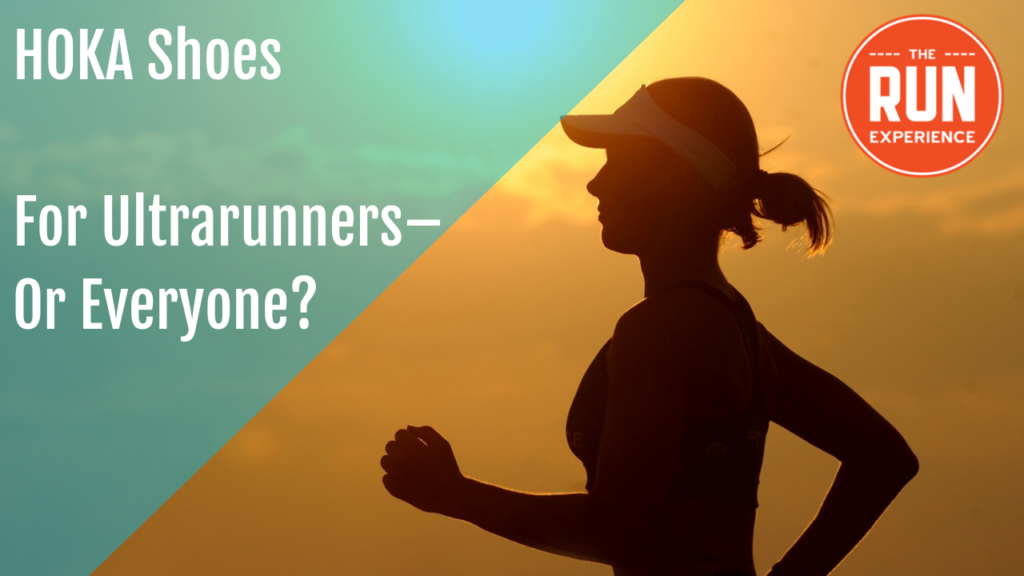Super Cushioned Shoes: Are HOKA Shoes Good for Runners or Not?

Maximalist cushioned running shoes are all the rage these days with athletes. So you know, talking about if HOKA shoes are good in a running blog might get a little fiery—maybe even a little weird.
After all, few things evoke more commentary, fervor, and zeal than a conversation around running shoes.
In this post, we’ll cover the research and our opinions about the best HOKA running shoes and if they’re good (or bad) for your running.
The Most Critical Equipment for Runners–Our Shoes
Runners tend to care a lot more about that thin–or in this case, ultra-thick–layer of rubber between them and the ground than they do about a lot of things.
For example–the next president, the name of their next child, or even the name of their current child.
Well, maybe not the last two things–sorry parents! Nevertheless, footwear ranks pretty darn high in the day-to-day of a runner.
Highly cushioned shoes such as the HOKA One One’s have become popular among runners who prefer a cushioned shoe. But first, we have to examine our intense relationship with shoes in the first place.
You might be saying, “Meeee? I don’t care that much about shoes. As IF!”
Yes, you. Unless you’re a Hobbit, you have an opinion. As for you barefoot runners out there–don’t think you’re excluded from this post. You guys are just as shoe-weird as the rest of us.
Before we dive into the controversial stuff, let’s remember the underlying belief that unites all runners.
We Believe Our Shoes Save Us
Shoes–or a certain type of shoe can save us, right? To put it another way, woe to the runner unjustly fit into the wrong shoe. That marathon? Gone in the blink of a Strava KOM, especially should the wrong shoes cup your heels.
Your friend who struggled through your last long run together with that IT band injury? Turns out he was in a moderate stability shoe with a 10mm drop, when he should have been in a high stability shoe and a 12mm drop.
So if all this certainty exists about the destroying power of the wrong shoe, how do we know when we have found the “right” pair?
The moment we hand our credit card over, we peek into the bag and see that minted cardboard box. You can smell that intoxicating new shoe smell. You don’t just see the right shoe anymore, you feel it.
We have a vision for the possibility and potential of the shoes. You might think, “I can do anything, run anywhere, and accomplish my major goals with this shoe.” We vibrate with a sense of hope, success, and perhaps a touch of nothing-can-stop-me invincibility as we exit the store.
Do Cushioned HOKA Running Shoes Hurt or Help?
Put aside your personal preferences for a moment. There various theories and research that help understand if cushioned shoes like HOKA’s are good for us or not.
Try not to pass judgment on any theory or study–take a moment to examine your own obsessive relationship with shoes. We all want our shoes to look right, be a certain color, have the precise size, and be the correct brand. Even choosing not to wear shoes is now a trend. Yes, there’s a lifestyle, product, and similar promises associated with virtually any fork in the road.
The question is–which fork have you chosen? Where do your loyalties lie, and why? Are your shoes responsible for your failure or success? Your injuries or crazy streak of health? Did your shoes get you to the Boston Marathon starting line or pave the way for your most recent 5K PR?
PSA of the Day: Get stronger, run more efficiently, and stay healthy with coaching from The Run Experience. Our two-week Run Fitness Formula will help you develop a foundation that builds strength, speed, and health. Plus, you get lifetime access to this excellent resource of over 50+ videos, workout tips, and coaching instructions. Sign up today!
Are HOKA Shoes Good?
The debate about whether HOKA shoes are good for you (specifically) might be up in the air, but there’s no debating the quality of these shoes. Yes, HOKA shoes are good.
Here’s why HOKA shoes are good:
- Innovation: Beyond the extra cushioning shoes, HOKA goes the extra mile to experiment with other design elements. From breathable uppers to carbon plate technology, they’re leading the way in terms of running shoe innovation.
- High-Quality Materials: HOKA makes there shoes out of high-quality, durable materials. You can get hundreds of miles out of these shoes, which isn’t the case with every other running shoe out there.
- Record-Setting: Many of the world’s running and course records were smashed by athletes wearing HOKA shoes. Now, it’s not all in the shoes, but I’d wager there’s more than a correlation.
Why HOKA Shoes Are Bad (Or Could Be Bad) | HOKA Controversy
Despite popular belief, researchers from the Spaulding National Running Center determined that highly cushioned shoes are not linked to lower levels of impact than traditional running shoes.
That’s why HOKA shoes are bad in some cases.
They found the opposite to be true—which is what sparks the HOKA controversy. The study showed that highly cushioned shoes come with a higher vertical average load rate and vertical instantaneous loading rate. Both of these promote overuse injuries like stress fractures and plantar fasciitis.
So while HOKA shoes for plantar fasciitis can help in some ways, they might also be hurting. In the end, it goes back to the thought that shoes don’t fix everything—they can help or hurt, but they won’t overcome poor training habits or running form.
Why? Aren’t those cushioned soles supposed to protect us?
“People actually land softer when they have less cushioning,” says Irene S. Davis, Ph.D., PT, a professor in the Department of Physical Medicine and Rehabilitation at Harvard Medical School and director of the Spaulding National Running Center. “Cushioning actually lulls you into thinking you can slam your foot into the ground.”
Benefits of Maximalist Cushioning
Maximalist cushioning in running shoes, like those offered by HOKA One One, has garnered significant attention and popularity among runners. While much of the praise is anecdotal, there are several benefits associated with this type of footwear that make it appealing to many athletes.
Impact Reduction
Maximalist cushioning is designed with thick, plush midsoles that absorb the shock of each footstrike. This design aims to reduce the impact on joints, which is particularly beneficial for long-distance runners and those with joint issues such as arthritis or previous injuries.
- Joint Protection: The enhanced cushioning helps to distribute the force of impact more evenly across the foot, potentially reducing stress on the ankles, knees, and hips.
- Reduced Fatigue: By absorbing more impact, these shoes can help decrease muscle fatigue during long runs, allowing runners to maintain better form and reduce the risk of injury.
- Softer Landings: Runners often report that maximalist shoes provide a softer, more forgiving landing, which can be particularly helpful on hard surfaces like pavement.
Many runners claim that the added cushioning in HOKA shoes has significantly reduced their joint pain and discomfort during and after runs. Testimonials often highlight how these shoes have allowed them to continue running despite chronic joint issues.
While the concept of impact reduction makes intuitive sense, not all studies have conclusively substantiated these benefits. Some research suggests that runners might alter their gait or footstrike in cushioned shoes, potentially offsetting some of the intended benefits. Therefore, the effectiveness of maximalist cushioning can vary from person to person.
Comfort and Support
Maximalist shoes like HOKA One One’s are designed to provide exceptional comfort and support. The thick cushioning conforms to the shape of the foot, offering a snug fit that supports the arch and heel.
- Enhanced Comfort: The plush midsoles and ample padding provide a luxurious feel, making these shoes comfortable for long runs and daily wear.
- Arch Support: Many HOKA models include built-in arch support, which can be beneficial for runners with flat feet or high arches.
- Injury Recovery: The extra cushioning can be particularly helpful for runners recovering from injuries, as it provides additional support and reduces the load on healing tissues.
Runners often praise HOKA shoes for their comfort, describing them as "running on clouds." This comfort can help runners extend their mileage and enjoy their runs more, contributing to a positive overall running experience.
Frequently Asked Questions About HOKA Shoes
Are HOKA shoes worth the money?
As far as quality goes, yes. Are they worth it for you (personally)? That depends. If the shoe fits, and you like the running experience, then we’d argue it’s probably worth the money. If you don’t notice a difference in your running form, experience, or recovery, it’s probably not worth it.
What’s running worth to you? Would you rather pay bills to the medical office or payments to the running store? That’s not necessarily the debate we’re making here with asking “are HOKA shoes worth the money,” but it’s a question you should answer to guide many of your running-related purchases.
What is so special about HOKA shoes?
HOKA was the first brand to embrace the maximalist cushion, but other brands have followed suit. Heck, Nike has some of the chunkiest shoes on the market now. However, athletes praise HOKA’s balance of quality, performance, and comfort.
There’s a reason some of the best ultrarunners in the world wear these shoes in competitions.
Why are these running shoes so chunky?
HOKA has built its shoes to withstand heavy pounding and volume. While they have chunky cushioning that extends the length of the shoe, it’s not just focused in the heel—which means that mid-foot and fore-foot strikers will equally benefit from a HOKA shoe. Theoretically.
Do HOKA shoes help with plantar fasciitis?
From a statistical standpoint, probably not. However, from an anecdotal perspective, there are thousands of athletes that claim HOKA shoes helped with their plantar fasciitis.
What are the best HOKA running shoes?
The best HOKA running shoes are entirely up to personal preference, but the ongoing Clifton line is the brand’s most popular (best-selling) HOKA shoe.
How long do HOKAs last?
It depends. Most HOKA shoes will last you that sweet spot between 300-500 miles, but that’s not where their optimal performance lies. You’ll usually kill the cushion long before then.
While you can continue using the shoe, you definitely won’t feel the springy energy you use to in the shoe’s early days out of the box.
What is the most cushioned HOKA shoe?
As of this publishing, HOKA’s Bondi shoe is the most cushioned HOKA shoe.
What are other shoes like HOKA?
Many brands are coming out with their own maximalist shoe. Even the Nike shoe worn by marathon-record-holder Eliud Kipchoge is a beefed-up, maximal cushioning shoe. On Cloud is probably the most similar HOKA shoe in consistency, but you can find extra cushioning shoes from just about any running brand.
On Cloud vs HOKA: what’s the difference?
On Cloud and HOKA both have an impressive lineup of shoes, but what are the differences between the two? First, you have the outsole design. Next, you have the innovation factor. Lastly, you could argue that HOKA-wearing athletes probably (probably) have better performances than On Cloud-wearing athletes.
Does that mean HOKA is better? Not necessarily. That’s up for you to decide.
Remember, Opinions on Super Cushion Shoes Vary
A 2015 New York Times article also discusses the worthiness of HOKA shoes. HOKA shoes have twice the amount of cushioning as standard running shoes–and were designed with ultrarunners who run races of 200+ miles in mind.
Still, the author mentions 1,500-meter Olympian Leo Manzana, who runs in Hoka One One shoes. Manzana had chronic plantar fasciitis that he said disappeared one week after he started wearing the HOKAs. In fact, he’s now sponsored by HOKA.

On the other hand, when I ran cross-country and track in college, I learned that highly cushioned shoes were not for me the hard way. In cushioned shoes, I experienced stress fractures every season. Once I switched to a lightweight trainer, poof–it never happened again.
Jerry Dicharry, a biochemist and author of Anatomy for Runners, says, “People are frustrated, and we’re told so often there’s a magic shoe that will stop our injuries. But that’s just not true.”
The bottom line? Everyone is different—from your running form to your mileage, there’s no one right shoe for everyone. Just like evaluating any shoe, if you wear super-cushioned shoes and have recurring injuries, you might want to reconsider if HOKA shoes are good for you.
A happy runner is a healthy runner with strong muscles, enjoying pain-free runs. Get started by downloading our FREE injury prevention video series or checking out one of our training programs for runners of all levels today!

